Fuel Cell Hybrid Electric Vehicles: A Review of Topologies and Energy Management Strategies
Abstract
:1. Introduction
2. Typical Topologies of FCHEVs
2.1. Fully FCEV
2.2. FC + Battery Hybridization
2.3. FC + UC Hybridization
2.4. FC + Battery + UC Hybridization
2.5. FC + Other Hybridization
3. Energy Management Strategies
3.1. Rule-Based Energy Management Strategies
3.2. Optimization-Based Energy Management Strategy
3.2.1. Offline Optimization-Based EMS
3.2.2. Online Optimization-Based EMS
3.3. Learning-Based EMS
3.4. EMS Based on Intelligent Vehicle Interconnection Technology
4. Conclusions and Suggestions
- To achieve a synergistic optimization of hydrogen consumption as well as durability of hybrid powertrain components, using a combination of multiple algorithms for energy management strategies, will be helpful. The multi-algorithm combination of energy management strategies has outstanding advantages over single-method energy management strategies in terms of real-time performance and level of optimization. For example, genetic algorithms are used to optimize rule-based energy management policies. The resulting new energy management strategy has the advantage of real-time and optimization. Researchers extensively combine various algorithms to develop better energy management strategies, which is a worthy research direction;
- Current V2V, V2I, and vehicle-to-everything (V2X) interconnected technologies, are developing rapidly. V2V communication enables vehicles to wirelessly exchange information about their speed, position, and heading, making vehicle speed predictions more accurate. At the same time, the current road information can be obtained in real time through V2I communication to make a more accurate judgment on the driving state and driving mode recognition of the vehicle. With the additional input of environmental information, the energy management strategy provides better real-time and optimization performance for FCHEVs;
- An energy management strategy is the core issue of a fuel cell hybrid power system. It is meaningful to ensure the efficiency of the energy management strategy in the whole life cycle scale of the system. Energy management strategies that can coordinate changes in internal parameters of energy storage components, and external multiple load scenarios in different use phases, will be an important direction. It is of great importance in the future health and safety of power battery systems, as well as efficient management aspects.
Author Contributions
Funding
Conflicts of Interest
References
- Luderer, G.; Madeddu, S.; Merfort, L.; Ueckerdt, F.; Pehl, M.; Pietzcker, R.; Rottoli, M.; Schreyer, F.; Bauer, N.; Baumstark, L.; et al. Impact of declining renewable energy costs on electrification in low-emission scenarios (vol 7, pg 32, 2022). Nat. Energy 2022, 7, 380–381. [Google Scholar] [CrossRef]
- Chang, X.Y.; Ma, T.; Wu, R. Impact of urban development on residents’ public transportation travel energy consumption in China: An analysis of hydrogen fuel cell vehicles alternatives. Int. J. Hydrogen Energy 2019, 44, 16015–16027. [Google Scholar] [CrossRef]
- Pan, R.; Yang, D.; Wang, Y.J.; Chen, Z.H. Performance degradation prediction of proton exchange membrane fuel cell using a hybrid prognostic approach. Int. J. Hydrogen Energy 2020, 45, 30994–31008. [Google Scholar] [CrossRef]
- Pan, R.; Yang, D.; Wang, Y.J.; Chen, Z.H. Health degradation assessment of proton exchange membrane fuel cell based on an analytical equivalent circuit model. Energy 2020, 207, 118185. [Google Scholar] [CrossRef]
- Wang, Y.; Wang, L.; Li, M.; Chen, Z. A review of key issues for control and management in battery and ultra-capacitor hybrid energy storage systems. Etransportation 2020, 4, 100064. [Google Scholar] [CrossRef]
- Wang, L.; Li, M.C.; Chen, Z.H. An Energy Management Strategy for Hybrid Energy Storage Systems coordinate with state of thermal and power. Control Eng. Pract. 2022, 122, 105122. [Google Scholar] [CrossRef]
- Wang, Y.J.; Sun, Z.D.; Li, X.Y.; Yang, X.Y.; Chen, Z.H. A comparative study of power allocation strategies used in fuel cell and ultracapacitor hybrid systems. Energy 2019, 189, 116142. [Google Scholar] [CrossRef]
- Wang, L.; Li, M.C.; Wang, Y.J.; Chen, Z.H. Energy Management Strategy and Optimal Sizing for Hybrid Energy Storage Systems Using an Evolutionary Algorithm. IEEE Trans. Intell. Transp. Syst. 2021, 1–11. [Google Scholar] [CrossRef]
- Mince, L.; Li, W.; Yujie, W.; Zonghai, C. Sizing Optimization and Energy Management Strategy for Hybrid Energy Storage System Using Multiobjective Optimization and Random Forests. IEEE Trans. Power Electron. 2021, 36, 11421–11430. [Google Scholar] [CrossRef]
- Wang, Y.J.; Sun, Z.D.; Chen, Z.H. Energy management strategy for battery/supercapacitor/fuel cell hybrid source vehicles based on finite state machine. Appl. Energy 2019, 254, 113707. [Google Scholar] [CrossRef]
- Zhang, H.T.; Li, X.G.; Liu, X.Z.; Yan, J.Y. Enhancing fuel cell durability for fuel cell plug-in hybrid electric vehicles through strategic power management. Appl. Energy 2019, 241, 483–490. [Google Scholar] [CrossRef]
- Kasimalla, V.K.; Srinivasulu, N.G.; Velisala, V. A review on energy allocation of fuel cell/battery/ultracapacitor for hybrid electric vehicles. Int. J. Energy Res. 2018, 42, 4263–4283. [Google Scholar] [CrossRef]
- Alcazar-Garcia, D.; Martinez, J.L.R. Model-based design validation and optimization of drive systems in electric, hybrid, plug-in hybrid and fuel cell vehicles. Energy 2022, 254, 123719. [Google Scholar] [CrossRef]
- Sulaiman, N.; Hannan, M.A.; Mohamed, A.; Ker, P.J.; Majlan, E.H.; Daud, W.R.W. Optimization of energy management system for fuel-cell hybrid electric vehicles: Issues and recommendations. Appl. Energy 2018, 228, 2061–2079. [Google Scholar] [CrossRef]
- Li, Q.; Yang, H.Q.; Han, Y.; Li, M.; Chen, W.R. A state machine strategy based on droop control for an energy management system of PEMFC-battery-supercapacitor hybrid tramway. Int. J. Hydrogen Energy 2016, 41, 16148–16159. [Google Scholar] [CrossRef]
- He, H.; Jia, C.; Li, J. A new cost-minimizing power-allocating strategy for the hybrid electric bus with fuel cell/battery health-aware control. Int. J. Hydrogen Energy 2022, 47, 22147–22164. [Google Scholar] [CrossRef]
- Pisal, P.S.; Vidyarthi, D.A. An optimal control for power management in super capacitors/battery of electric vehicles using Deep Neural Network. J. Power Sources 2022, 542, 231696. [Google Scholar] [CrossRef]
- Li, S.Q.; He, H.W.; Zhao, P.F. Energy management for hybrid energy storage system in electric vehicle: A cyber-physical system perspective. Energy 2021, 230, 120890. [Google Scholar] [CrossRef]
- Iqbal, M.; Becherif, M.; Ramadan, H.S.; Badji, A. Dual-layer approach for systematic sizing and online energy management of fuel cell hybrid vehicles. Appl. Energy 2021, 300, 117345. [Google Scholar] [CrossRef]
- Fu, Z.; Zhu, L.; Tao, F.; Si, P.; Sun, L. Optimization based energy management strategy for fuel cell/battery/ultracapacitor hybrid vehicle considering fuel economy and fuel cell lifespan. Int. J. Hydrogen Energy 2020, 45, 8875–8886. [Google Scholar] [CrossRef]
- Luo, Y.; Wu, Y.; Li, B.; Qu, J.; Feng, S.-P.; Chu, P.K. Optimization and cutting-edge design of fuel-cell hybrid electric vehicles. Int. J. Energy Res. 2021, 45, 18392–18423. [Google Scholar] [CrossRef]
- Das, H.S.; Tan, C.W.; Yatim, A.H.M. Fuel cell hybrid electric vehicles: A review on power conditioning units and topologies. Renew. Sustain. Energy Rev. 2017, 76, 268–291. [Google Scholar] [CrossRef]
- Lu, X.; Qu, Y.; Wang, Y.; Qin, C.; Liu, G. A comprehensive review on hybrid power system for PEMFC-HEV: Issues and strategies. Energy Convers. Manag. 2018, 171, 1273–1291. [Google Scholar] [CrossRef]
- Zhou, W.; Yang, L.; Cai, Y.S.; Ying, T.X. Dynamic programming for new energy vehicles based on their work modes Part II: Fuel cell electric vehicles. J. Power Sources 2018, 407, 92–104. [Google Scholar] [CrossRef]
- Ghavidel, H.F.; Mousavi, S.M.G. Modeling analysis, control, and type-2 fuzzy energy management strategy of hybrid fuel cell-battery-supercapacitor systems. J. Energy Storage 2022, 51, 104456. [Google Scholar] [CrossRef]
- Wang, Y.; Advani, S.G.; Prasad, A.K. A comparison of rule-based and model predictive controller-based power management strategies for fuel cell/battery hybrid vehicles considering degradation. Int. J. Hydrogen Energy 2020, 45, 33948–33956. [Google Scholar] [CrossRef]
- Chuanlong, J.; Liang, Q.; Zhiqiang, Z.; Yan, Z. Research on Energy Management Strategy of Vehicle Fuel Cell-Battery Hybrid Energy System Based on GT-SUIT/Simulink. J. Phys. Conf. Ser. 2021, 1885, 042067. [Google Scholar] [CrossRef]
- Zheng, C.H.; Oh, C.E.; Park, Y.I.; Cha, S.W. Fuel economy evaluation of fuel cell hybrid vehicles based on equivalent fuel consumption. Int. J. Hydrogen Energy 2012, 37, 1790–1796. [Google Scholar] [CrossRef]
- Wang, Y.J.; Sun, Z.D.; Chen, Z.H. Development of energy management system based on a rule-based power distribution strategy for hybrid power sources. Energy 2019, 175, 1055–1066. [Google Scholar] [CrossRef]
- Yu, S.; Kai, H.; Xiaolong, L. Study on the fuel economy of fuel cell electric vehicle based on rule-based energy management strategies. Int. J. Powertrains 2021, 10, 266–292. [Google Scholar] [CrossRef]
- Li, H.; Ravey, A.; N’Diaye, A.; Djerdir, A. A novel equivalent consumption minimization strategy for hybrid electric vehicle powered by fuel cell, battery and supercapacitor. J. Power Sources 2018, 395, 262–270. [Google Scholar] [CrossRef]
- Farhadi Gharibeh, H.; Farrokhifar, M. Online Multi-Level Energy Management Strategy Based on Rule-Based and Optimization-Based Approaches for Fuel Cell Hybrid Electric Vehicles. Appl. Sci. 2021, 11, 3849. [Google Scholar] [CrossRef]
- Liu, Y.; Liu, J.; Qin, D.; Li, G.; Chen, Z.; Zhang, Y. Online energy management strategy of fuel cell hybrid electric vehicles based on rule learning. J. Clean. Prod. 2020, 260, 121017. [Google Scholar] [CrossRef]
- Alloui, H.; Khoucha, F.; Rizoug, N.; Benbouzid, M.; Kheloui, A. Comparative study between rule-based and frequency separation energy management strategies within fuel-cell/battery electric vehicle. In Proceedings of the 2017 IEEE International Conference on Environment and Electrical Engineering and 2017 IEEE Industrial and Commercial Power Systems Europe (EEEIC/I&CPS Europe), Milan, Italy, 6–9 June 2017. [Google Scholar] [CrossRef]
- Geng, C.; Jin, X.; Zhang, X. Simulation research on a novel control strategy for fuel cell extended-range vehicles. Int. J. Hydrogen Energy 2017 2019, 44, 408–420. [Google Scholar] [CrossRef]
- Badji, A.; Abdeslam, D.O.; Chabane, D.; Benamrouche, N. Real-time implementation of improved power frequency approach based energy management of fuel cell electric vehicle considering storage limitations. Energy 2022, 249, 123743. [Google Scholar] [CrossRef]
- Lu, X.Q.; Wu, Y.B.; Lian, J.; Zhang, Y.Y.; Chen, C.; Wang, P.S.; Meng, L.Z. Energy management of hybrid electric vehicles: A review of energy optimization of fuel cell hybrid power system based on genetic algorithm. Energy Convers. Manag. 2020, 205, 112474. [Google Scholar] [CrossRef]
- Yue, M.; Jemei, S.; Zerhouni, N. Health-Conscious Energy Management for Fuel Cell Hybrid Electric Vehicles Based on Prognostics-Enabled Decision-Making. IEEE Trans. Veh. Technol. 2019, 68, 11483–11491. [Google Scholar] [CrossRef]
- Liu, H.; Chen, J.; Wu, C.; Chen, H. Multi-objective optimization for energy management of fuel cell hybrid electric vehicles. In Proceedings of the 2018 American Control Conference (ACC), Milwaukee, WI, USA, 27–29 June 2018; American Control Conference: Milwaukee, WI, USA, 2018. [Google Scholar]
- He, H.; Wang, X.; Chen, J.; Wang, Y.-X. Regenerative Fuel Cell-Battery-Supercapacitor Hybrid Power System Modeling and Improved Rule-Based Energy Management for Vehicle Application. J. Energy Eng. 2020, 146, 04020060. [Google Scholar] [CrossRef]
- Du, C.; Huang, S.; Jiang, Y.; Wu, D.; Li, Y. Optimization of Energy Management Strategy for Fuel Cell Hybrid Electric Vehicles Based on Dynamic Programming. Energies 2022, 15, 4325. [Google Scholar] [CrossRef]
- Liu, C.; Wang, Y.; Wang, L.; Chen, Z. Load-adaptive real-time energy management strategy for battery/ultracapacitor hybrid energy storage system using dynamic programming optimization. J. Power Sources 2019, 438, 227024. [Google Scholar] [CrossRef]
- Zheng, C.; Ningyuan, G.; Qiang, Z.; Jiangwei, S.; Renxin, X. An Optimized Rule Based Energy Management Strategy for a Fuel Cell/Battery Vehicle. In Proceedings of the 2017 IEEE Vehicle Power and Propulsion Conference (VPPC), Belfort, France, 11–14 December 2017. [Google Scholar] [CrossRef]
- Zhou, Y.; Ravey, A.; Pera, M.-C. Real-time cost-minimization power-allocating strategy via model predictive control for fuel cell hybrid electric vehicles. Energy Convers. Manag. 2021, 229, 113721. [Google Scholar] [CrossRef]
- Sun, X.; Zhou, Y.; Zhang, X.; Huang, L.; Lian, J. Real-time optimal EMS of adaptive charge sustenance for fuel cell hybrid buses based on driving characteristics recognition. Energy Convers. Manag. 2022, 254, 115192. [Google Scholar] [CrossRef]
- Sun, X.; Zhou, Y.; Huang, L.; Lian, J. A real-time PMP energy management strategy for fuel cell hybrid buses based on driving segment feature recognition. Int. J. Hydrogen Energy 2021, 46, 39983–40000. [Google Scholar] [CrossRef]
- Song, K.; Wang, X.; Li, F.; Sorrentino, M.; Zheng, B. Pontryagin’s minimum principle-based real-time energy management strategy for fuel cell hybrid electric vehicle considering both fuel economy and power source durability. Energy 2020, 205, 118064. [Google Scholar] [CrossRef]
- Huangfu, Y.; Li, P.; Pang, S.; Tian, C.; Quan, S.; Zhang, Y.; Wei, J. An Improved Energy Management Strategy for Fuel Cell Hybrid Vehicles Based on Pontryagin’s Minimum Principle. IEEE Trans. Ind. Appl. 2022, 58, 4086–4097. [Google Scholar] [CrossRef]
- Meng, X.; Li, Q.; Wang, X.; Gan, R.; Zhang, G.; Chen, W. A Fuel Cell Vehicle Power Distribution Strategy based on PEMFC Online Identification and ESS Equivalent Consumption Calculation. In Proceedings of the 2020 IEEE Transportation Electrification Conference and Expo (ITEC), Chicago, IL, USA, 23–26 June 2020. [Google Scholar]
- Mounica, V.; Obulesu, Y.P. Hybrid Power Management Strategy with Fuel Cell, Battery, and Supercapacitor for Fuel Economy in Hybrid Electric Vehicle Application. Energies 2022, 15, 4185. [Google Scholar] [CrossRef]
- Yue, M.L.; Al Masry, Z.; Jemei, S.; Zerhouni, N. An online prognostics-based health management strategy for fuel cell hybrid electric vehicles. Int. J. Hydrogen Energy 2021, 46, 13206–13218. [Google Scholar] [CrossRef]
- Zhou, Y.; Ravey, A.; Pera, M.C. Multi-mode predictive energy management for fuel cell hybrid electric vehicles using Markov driving pattern recognizer. Appl. Energy 2020, 258, 114057. [Google Scholar] [CrossRef]
- Li, H.; Ravey, A.; N’Diaye, A.; Djerdir, A. Online adaptive equivalent consumption minimization strategy for fuel cell hybrid electric vehicle considering power sources degradation. Energy Convers. Manag. 2019, 192, 133–149. [Google Scholar] [CrossRef]
- Ou, K.; Yuan, W.-W.; Choi, M.; Yang, S.; Jung, S.; Kim, Y.-B. Optimized power management based on adaptive-PMP algorithm for a stationary PEM fuel cell/battery hybrid system. Int. J. Hydrogen Energy 2018, 43, 15433–15444. [Google Scholar] [CrossRef]
- Fu, J.; Fu, Z.; Song, S. Energy management strategy integrating self-adaptive adjustment and Pontryagin’s minimum principle-based optimization for fuel-cell hybrid electric vehicle. Optim. Control Appl. Methods 2022, 43, 1059–1075. [Google Scholar] [CrossRef]
- Li, X.; Wang, Y.; Yang, D.; Chen, Z. Adaptive energy management strategy for fuel cell/battery hybrid vehicles using Pontryagin’s Minimal Principle. J. Power Sources 2019, 440, 227105. [Google Scholar] [CrossRef]
- Iqbal, M.; Laurent, J.; Benmouna, A.; Becherif, M.; Ramadan, H.S.; Claude, F. Ageing-aware load following control for composite-cost optimal energy management of fuel cell hybrid electric vehicle. Energy 2022, 254, 124233. [Google Scholar] [CrossRef]
- Zhang, Y.J.; Huang, Y.J.; Chen, Z.; Li, G.; Liu, Y.G. A Novel Learning-Based Model Predictive Control Strategy for Plug-In Hybrid Electric Vehicle. IEEE Trans. Transp. Electrif. 2022, 8, 23–35. [Google Scholar] [CrossRef]
- Ma, Y.; Li, C.; Wang, S. Multi-objective energy management strategy for fuel cell hybrid electric vehicle based on stochastic model predictive control. ISA Trans. 2022, in press. [Google Scholar] [CrossRef] [PubMed]
- Yazdani, A.; Bidarvatan, M. Real-Time Optimal Control of Power Management in a Fuel Cell Hybrid Electric Vehicle: A Comparative Analysis. SAE Int. J. Altern. Powertrains 2018, 7, 43–53. [Google Scholar] [CrossRef]
- Anbarasu, A.; Dinh, T.Q.; Sengupta, S. Novel enhancement of energy management in fuel cell hybrid electric vehicle by an advanced dynamic model predictive control. Energy Convers. Manag. 2022, 267, 115883. [Google Scholar] [CrossRef]
- Fu, J.; Zeng, L.; Lei, J.; Deng, Z.; Fu, X.; Li, X.; Wang, Y. A Real-Time Load Prediction Control for Fuel Cell Hybrid Vehicle. Energies 2022, 15, 3700. [Google Scholar] [CrossRef]
- Zhou, Y.; Ravey, A.; Pera, M.C. Multi-objective energy management for fuel cell electric vehicles using online-learning enhanced Markov speed predictor. Energy Convers. Manag. 2020, 213, 112821. [Google Scholar] [CrossRef]
- Yuan, J.; Yang, L.; Chen, Q. Intelligent energy management strategy based on hierarchical approximate global optimization for plug-in fuel cell hybrid electric vehicles. Int. J. Hydrogen Energy 2018, 43, 8063–8078. [Google Scholar] [CrossRef]
- Zhou, D.; Al-Durra, A.; Ravey, A.; Matraji, I.; Gao, F. Online Energy Management Strategy of Fuel Cell Hybrid Electric Vehicles: A Fractional-Order Extremum Seeking Method. IEEE Trans. Ind. Electron. 2018, 65, 6787–6799. [Google Scholar] [CrossRef]
- Zhou, D.M.; Ravey, A.; Al-Durra, A.; Gao, F. A comparative study of extremum seeking methods applied to online energy management strategy of fuel cell hybrid electric vehicles. Energy Convers. Manag. 2017, 151, 778–790. [Google Scholar] [CrossRef]
- Zhou, D.M.; Al-Durra, A.; Gao, F.; Ravey, A.; Matraji, I.; Simoes, M.G. Online energy management strategy of fuel cell hybrid electric vehicles based on data fusion approach. J. Power Sources 2017, 366, 278–291. [Google Scholar] [CrossRef]
- Jia, C.; Cui, J.; Qiao, W.; Qu, L. A Real-time Operational Cost Minimization Strategy for Energy Management of Fuel Cell Electric Vehicles. In Proceedings of the 2021 13th IEEE Energy Conversion Congress and Exposition (ECCE), Vancouver, BC, Canada, 10–14 October 2021. [Google Scholar]
- Sun, Z.; Wang, Y.; Chen, Z.; Li, X. Min-max game based energy management strategy for fuel cell/supercapacitor hybrid electric vehicles. Appl. Energy 2020, 267, 115086. [Google Scholar] [CrossRef]
- Ghaderi, R.; Kandidayeni, M.; Soleymani, M.; Boulon, L.; Trovao, J.P.F. Online Health-Conscious Energy Management Strategy for a Hybrid Multi-Stack Fuel Cell Vehicle Based on Game Theory. IEEE Trans. Veh. Technol. 2022, 71, 5704–5714. [Google Scholar] [CrossRef]
- Koubaa, R.; Bacha, S.; Smaoui, M.; Krichen, L. Robust optimization based energy management of a fuel cell/ ultra-capacitor hybrid electric vehicle under uncertainty. Energy 2020, 200, 117530. [Google Scholar] [CrossRef]
- Wu, J.; Zhang, N.; Tan, D.; Chang, J.; Shi, W. A robust online energy management strategy for fuel cell/battery hybrid electric vehicles. Int. J. Hydrogen Energy 2020, 45, 14093–14107. [Google Scholar] [CrossRef]
- Li, Q.; Meng, X.; Gao, F.; Zhang, G.; Chen, W. Approximate Cost-Optimal Energy Management of Hydrogen Electric Multiple Unit Trains Using Double Q-Learning Algorithm. IEEE Trans. Ind. Electron. 2022, 69, 9099–9110. [Google Scholar] [CrossRef]
- Bo, L.; Han, L.; Xiang, C.; Liu, H.; Ma, T. A Q-learning fuzzy inference system based online energy management strategy for off-road hybrid electric vehicles. Energy 2022, 252, 123976. [Google Scholar] [CrossRef]
- Tao, J.; Zhang, R.; Qiao, Z.; Ma, L. Q-Learning-based fuzzy energy management for fuel cell/supercapacitor HEV. Trans. Inst. Meas. Control. 2022, 44, 1939–1949. [Google Scholar] [CrossRef]
- Guo, L.; Li, Z.; Outbib, R. Reinforcement Learning based Energy Management for Fuel Cell Hybrid Electric Vehicles. In Proceedings of the IECON 2021—47th Annual Conference of the IEEE Industrial Electronics Society, Toronto, ON, Canada, 13–16 October 2021. [Google Scholar] [CrossRef]
- Lin, X.; Zeng, S.; Li, X. Online correction predictive energy management strategy using the Q-learning based swarm optimization with fuzzy neural network. Energy 2021, 223, 120071. [Google Scholar] [CrossRef]
- Tang, X.L.; Zhou, H.T.; Wang, F.; Wang, W.D.; Lin, X.K. Longevity-conscious energy management strategy of fuel cell hybrid electric Vehicle Based on deep reinforcement learning. Energy 2022, 238, 121593. [Google Scholar] [CrossRef]
- Zhang, Y.X.; Ma, R.; Zhao, D.D.; Huangfu, Y.G.; Liu, W.G. A Novel Energy Management Strategy Based on Dual Reward Function Q-learning for Fuel Cell Hybrid Electric Vehicle. IEEE Trans. Ind. Electron. 2022, 69, 1537–1547. [Google Scholar] [CrossRef]
- Sun, H.; Fu, Z.; Tao, F.; Zhu, L.; Si, P. Data-driven reinforcement-learning-based hierarchical energy management strategy for fuel cell/battery/ultracapacitor hybrid electric vehicles. J. Power Sources 2020, 455, 227964. [Google Scholar] [CrossRef]
- Fu, Z.; Wang, H.; Tao, F.; Ji, B.; Dong, Y.; Song, S. Energy Management Strategy for Fuel Cell/Battery/Ultracapacitor Hybrid Electric Vehicles Using Deep Reinforcement Learning With Action Trimming. IEEE Trans. Veh. Technol. 2022, 71, 7171–7185. [Google Scholar] [CrossRef]
- Zhou, Y.F.; Huang, L.J.; Sun, X.X.; Li, L.H.; Lian, J. A Long-term Energy Management Strategy for Fuel Cell Electric Vehicles Using Reinforcement Learning. Fuel Cells 2020, 20, 753–761. [Google Scholar] [CrossRef]
- Li, W.; Ye, J.Y.; Cui, Y.N.; Kim, N.; Cha, S.W.; Zheng, C.H. A Speedy Reinforcement Learning-Based Energy Management Strategy for Fuel Cell Hybrid Vehicles Considering Fuel Cell System Lifetime. Int. J. Precis. Eng. Manuf.-Green Technol. 2022, 9, 859–872. [Google Scholar] [CrossRef]
- Kim, D.; Hong, S.; Cui, S.; Joe, I. Deep Reinforcement Learning-Based Real-Time Joint Optimal Power Split for Battery-Ultracapacitor-Fuel Cell Hybrid Electric Vehicles. Electronics 2022, 11, 1850. [Google Scholar] [CrossRef]
- Ali, A.M.; Yacoub, M.I. Optimal predictive power management strategy for fuel cell electric vehicles using neural networks in real-time. In Proceedings of the 2020 IEEE Vehicle Power and Propulsion Conference (VPPC), Gijón, Spain, 26–29 October 2020. [Google Scholar] [CrossRef]
- Li, C.; Hu, G.; Zhu, Z.; Wang, X.; Jiang, W. Adaptive equivalent consumption minimization strategy and its fast implementation of energy management for fuel cell electric vehicles. Int. J. Energy Res. 2022, 46, 16005–16018. [Google Scholar] [CrossRef]
- Min, D.H.; Song, Z.; Chen, H.C.; Wang, T.X.; Zhang, T. Genetic algorithm optimized neural network based fuel cell hybrid electric vehicle energy management strategy under start-stop condition. Appl. Energy 2022, 306, 118036. [Google Scholar] [CrossRef]
- Zhang, Y.; Huang, Z.; Zhang, C.; Lv, C.; Deng, C.; Hao, D.; Chen, J.; Ran, H. Improved Short-Term Speed Prediction Using Spatiotemporal-Vision-Based Deep Neural Network for Intelligent Fuel Cell Vehicles. IEEE Trans. Ind. Inform. 2021, 17, 6004–6013. [Google Scholar] [CrossRef]
- Liu, B.; Sun, C.; Wang, B.; Liang, W.; Ren, Q.; Li, J.; Sun, F. Bilevel convex optimization of eco-driving for connected Fuel Cell Hybrid Electric Vehicles through signalized intersections. Energy 2022, 252, 123956. [Google Scholar] [CrossRef]
- Nie, Z.; Jia, Y.; Wang, W.; Outbib, R. Eco-Co-Optimization strategy for connected and automated fuel cell hybrid vehicles in dynamic urban traffic settings. Energy Convers. Manag. 2022, 263, 115690. [Google Scholar] [CrossRef]
- Nie, Z.; Jia, Y.; Wang, W.; Chen, Z.; Outbib, R. Co-optimization of speed planning and energy management for intelligent fuel cell hybrid vehicle considering complex traffic conditions. Energy 2022, 247, 123476. [Google Scholar] [CrossRef]
- Zhu, L.; Tao, F.; Fu, Z.; Wang, N.; Ji, B.; Dong, Y. Optimization Based Adaptive Cruise Control and Energy Management Strategy for Connected and Automated FCHEV. IEEE Trans. Intell. Transp. Syst. 2022, 1–10. [Google Scholar] [CrossRef]
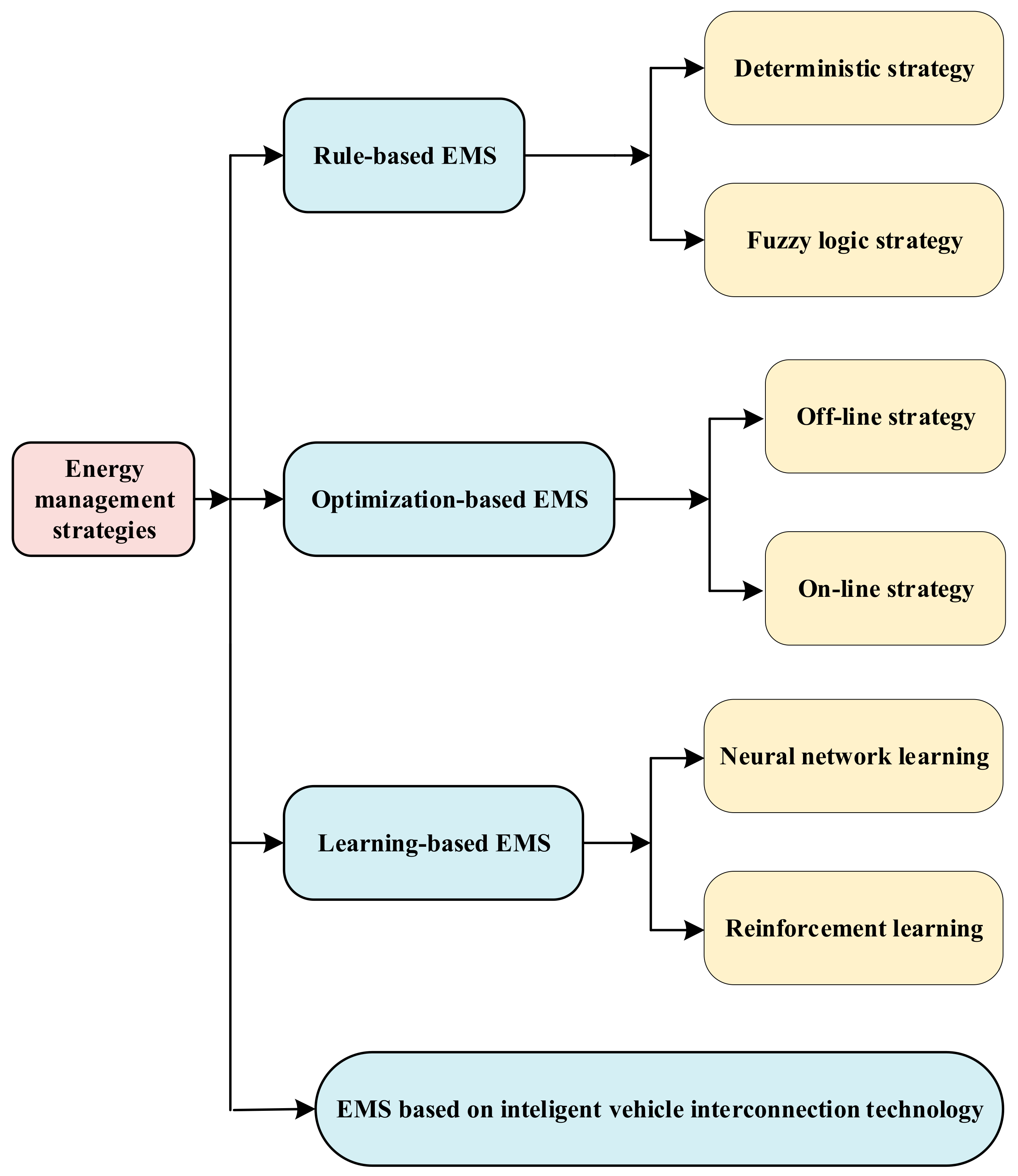
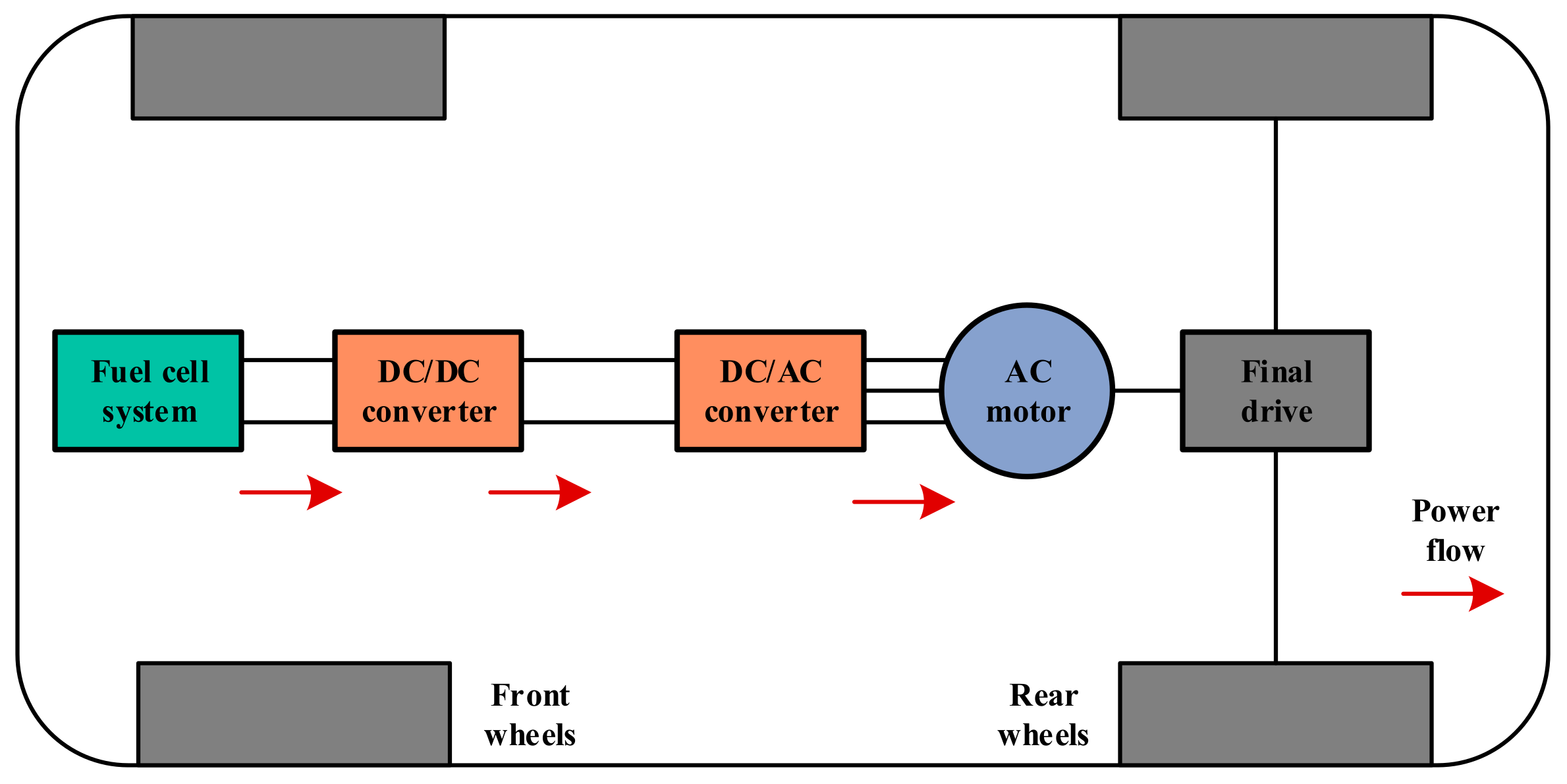
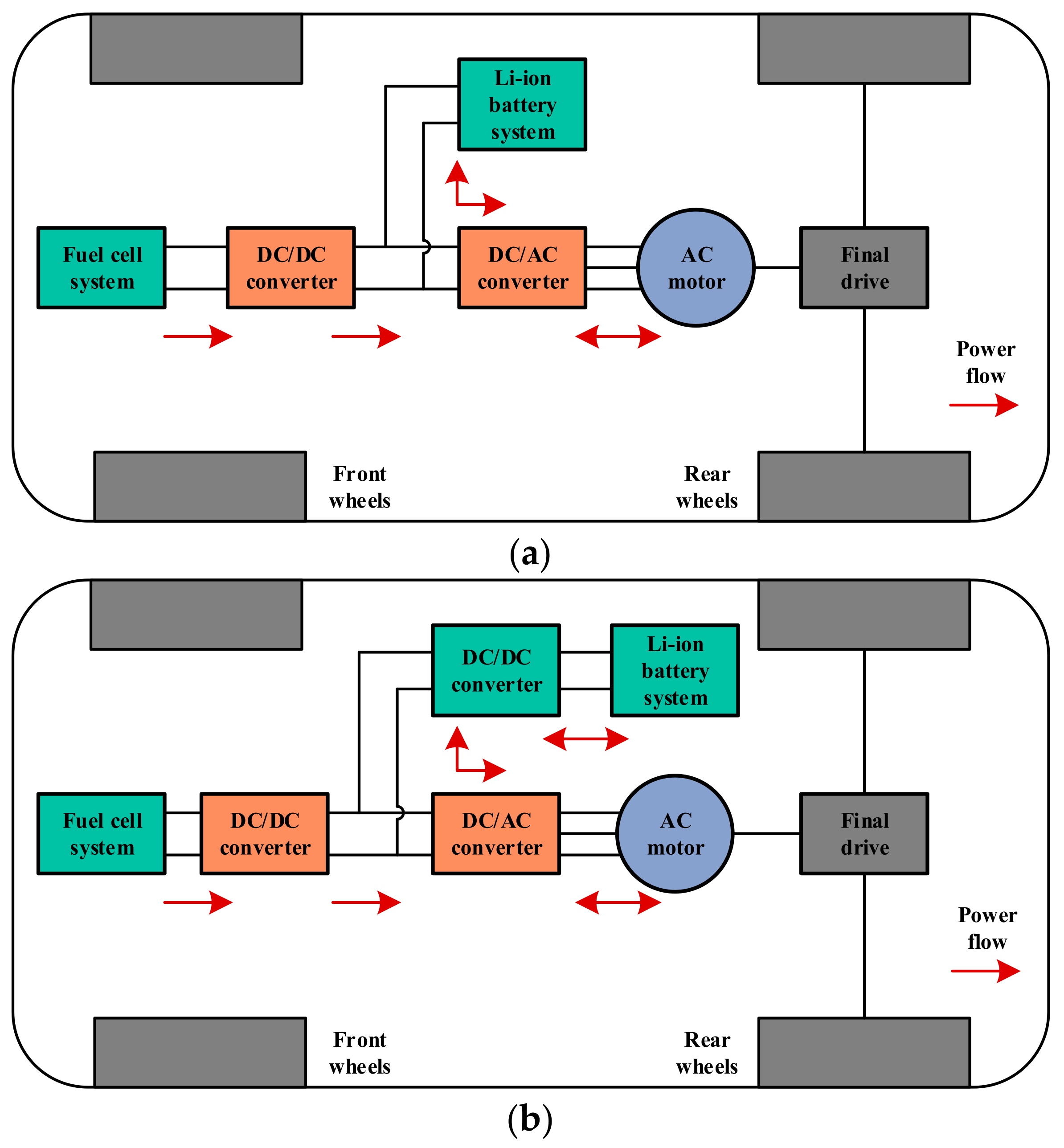
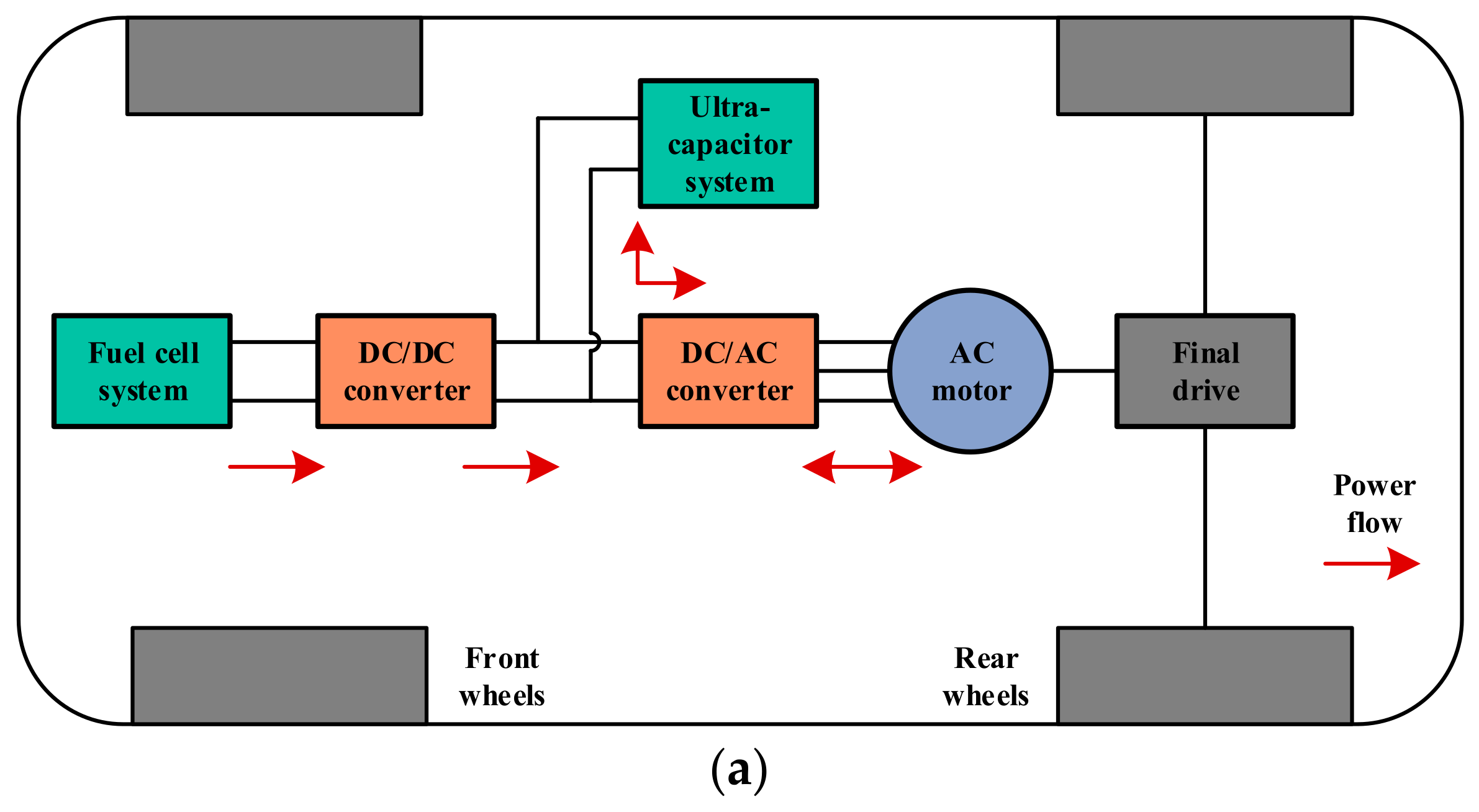
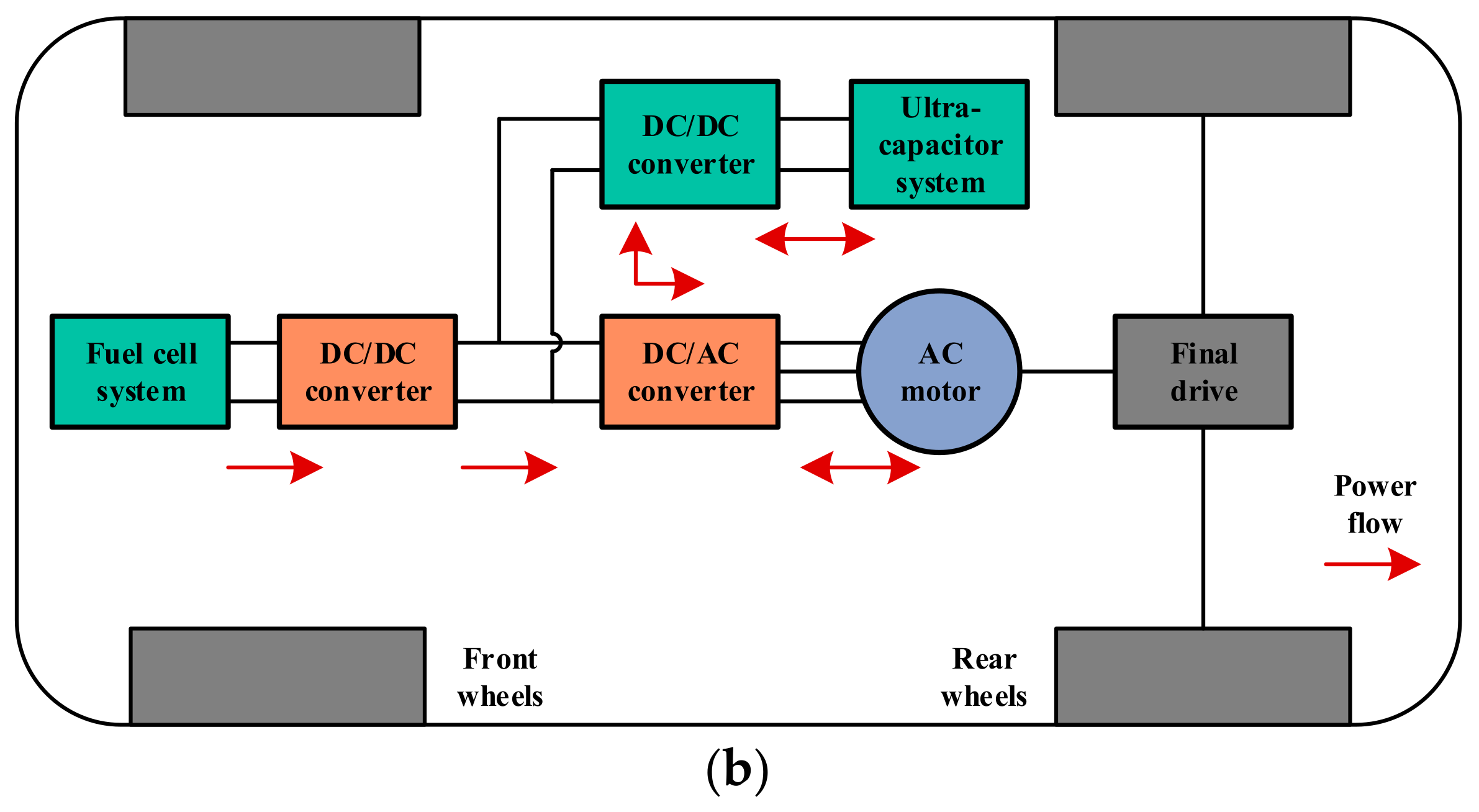
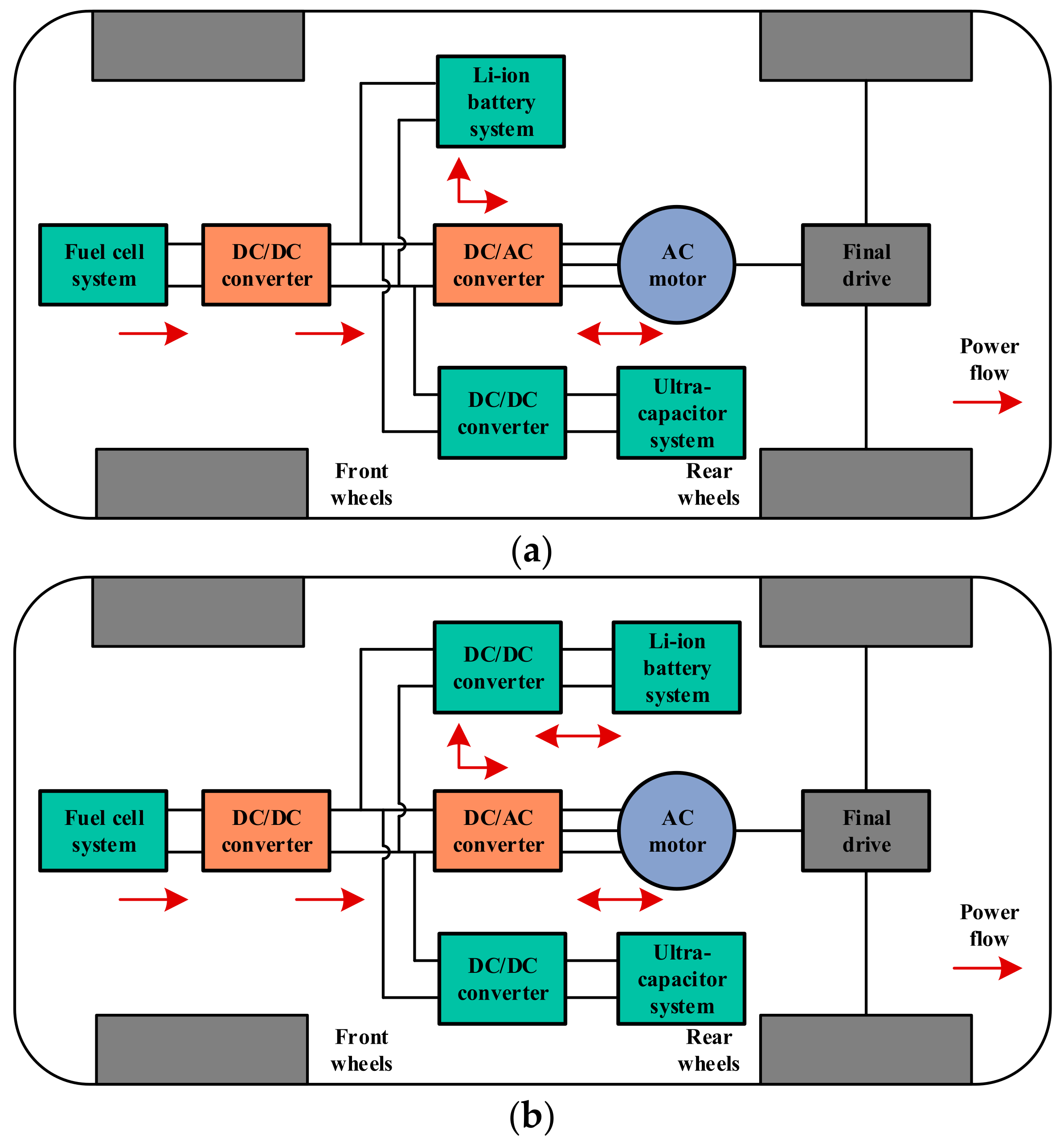
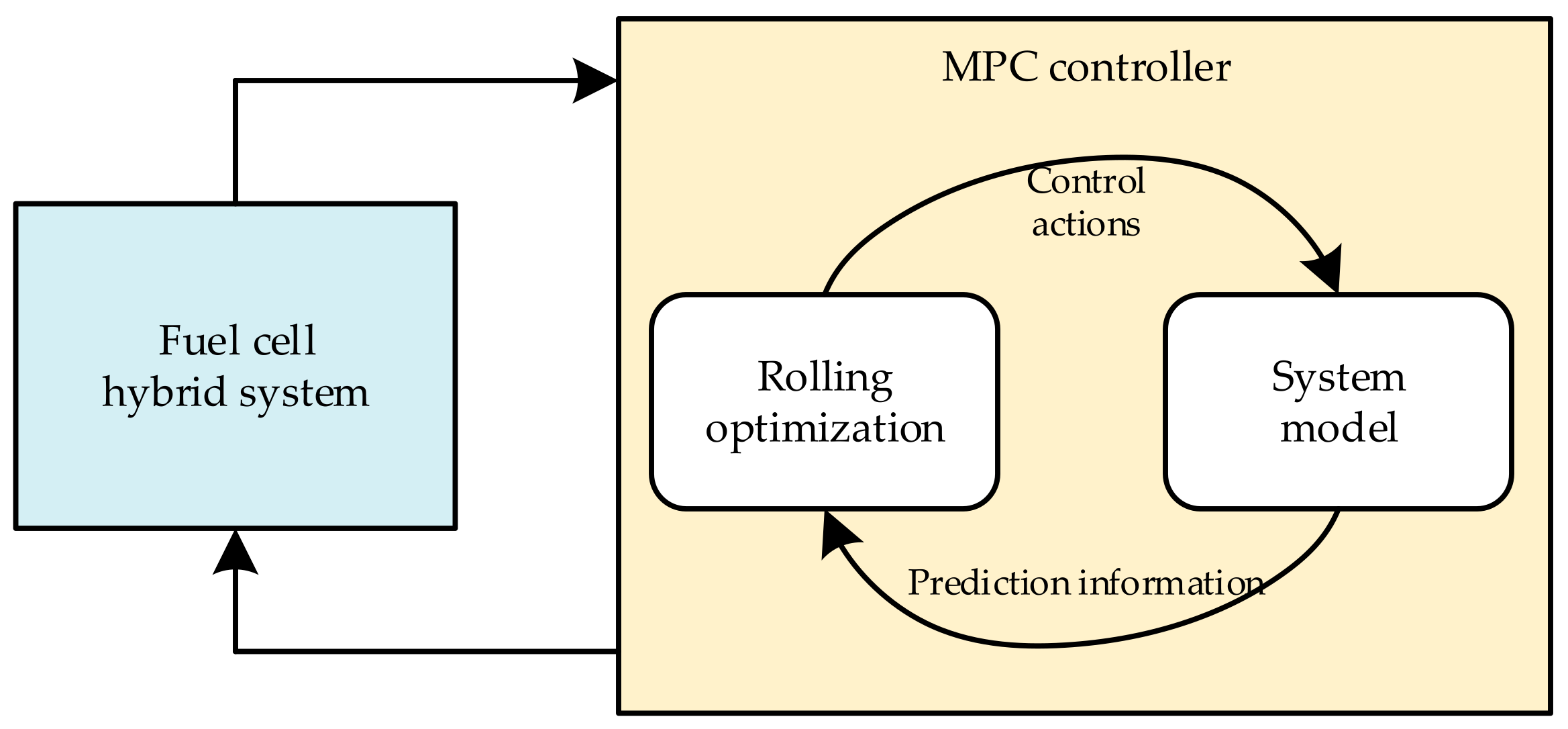


| Topological Classifications | Main Advantages | Main Disadvantages |
|---|---|---|
| Fully FCEV |
|
|
| FC + Battery hybridization |
|
|
| FC + UC hybridization |
|
|
| FC + battery + UC hybridization |
|
|
| EMS Type | Main Advantages | Main Disadvantages |
|---|---|---|
| Rule-based strategies |
|
|
| Optimization-based strategies (offline) |
|
|
| Optimization-based strategies (online) |
|
|
| Learning-based strategies |
|
|
| EMS based on intelligent vehicle interconnection technology |
|
|
Publisher’s Note: MDPI stays neutral with regard to jurisdictional claims in published maps and institutional affiliations. |
© 2022 by the authors. Licensee MDPI, Basel, Switzerland. This article is an open access article distributed under the terms and conditions of the Creative Commons Attribution (CC BY) license (https://creativecommons.org/licenses/by/4.0/).
Share and Cite
Yu, P.; Li, M.; Wang, Y.; Chen, Z. Fuel Cell Hybrid Electric Vehicles: A Review of Topologies and Energy Management Strategies. World Electr. Veh. J. 2022, 13, 172. https://doi.org/10.3390/wevj13090172
Yu P, Li M, Wang Y, Chen Z. Fuel Cell Hybrid Electric Vehicles: A Review of Topologies and Energy Management Strategies. World Electric Vehicle Journal. 2022; 13(9):172. https://doi.org/10.3390/wevj13090172
Chicago/Turabian StyleYu, Pengli, Mince Li, Yujie Wang, and Zonghai Chen. 2022. "Fuel Cell Hybrid Electric Vehicles: A Review of Topologies and Energy Management Strategies" World Electric Vehicle Journal 13, no. 9: 172. https://doi.org/10.3390/wevj13090172
APA StyleYu, P., Li, M., Wang, Y., & Chen, Z. (2022). Fuel Cell Hybrid Electric Vehicles: A Review of Topologies and Energy Management Strategies. World Electric Vehicle Journal, 13(9), 172. https://doi.org/10.3390/wevj13090172









